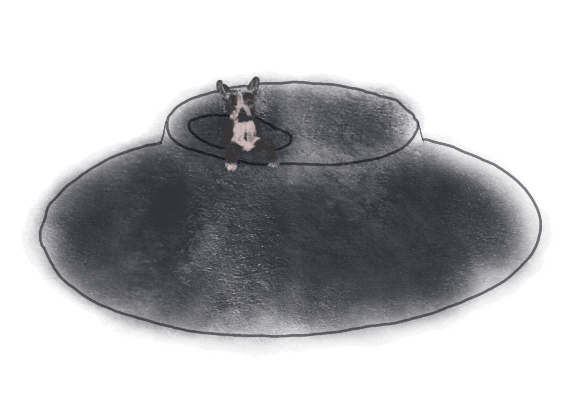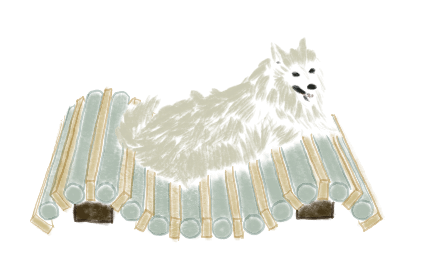The Scale of Man's Best Friend - Architecture for Dogs
Pets, in particular, dogs hold a special place in my heart as they are generally loving creatures that are a joy to be around. When Architecture for Dogs exhibition was announced to be exhibited in Japan House in London between September 2020 to January 2021, I took the chance to visit it with some of my dog-loving friends. Architecture for Dogs exhibition is a collection of architectural designs for dogs by leading architects and designers in the world. The bespoke designs each have a dog breed in mind, designing the architecture for dogs in relation to the size of a bichon frise, shiba inu, teacup poodle, etc.
Displaying full-scale prototypes of the architecture for dogs, the exhibition is also interactive, inviting dog owners to bring well-behaved dogs up to 45.5cm to the exhibition to interact with one section of the exhibition. The dedicated interactive section encourages visitors as well as dogs to freely touch, explore, and use the architecture for dogs; helpful exhibition assistants are present with dog treats too, how wonderful is it to have a real dog test out the architectural pieces?
As Architecture for Dogs was organised and launched by Kenya Hara, let me share the architect’s description for his design for a teacup poodle:
“When the dog runs up the stairs, he ends up at just the right height to be face-to-face with a person. I thought up an installation that equalizes human scale and dog scale, or in other words, a scale modifier.”
“People have designed their environments to their own scale. For instance, each step of a stairway is 15cm high, around the world. This came to be naturally because of the height of humans and the length of their feet. The same goes for the heights of chairs and tables, the existence and size of doors, in fact, the size of houses and cities are based on the human body. Accordingly, dogs, who spend their lives at the side of humans, must accept human scale.”
The foundations for any design projects, in particular, architecture projects is the Project Brief. I strongly believe that a well-written project brief is one of the crucial elements that pave the way for any project’s success. And for this super-small dog who spends all his time looking up, this project brief and execution definitely puts its user at the heart.
For this design for a Japanese terrier, Hara Design Institute, a design section within the Nippon Design Center supervised by Kenya Hara, choose to create a house without walls for the dog. With just a floating roof, at certain moments, what you can see is only the tiny legs and paws of the dog who is at home.
Blueprints for most of the pieces on Architecture for Dogs are available to download. Filled with details of the information of the pieces required to the easy-to-follow assembly instruction, the exhibition gives visitors a chance to build an architecture for their dogs too. I found the Pointed T piece a fun and straightforward piece because it does not require any construction tools - it is a great weekend project to add some personal space for your dog if they are of a similar size to a typical Japanese terrier.
For this dachshund smooth, the sloped architectural piece allows it to climb up and down the piece, giving it a higher viewing point that it wouldn't normally see. Atelier Bow-Wow also considered how a dog's owner interacts with their dog, informing the length of the sloped pieces to allow the owner to lie down next to their dog. Following Kenya Hara's quote about "installation that equalizes human scale and dog scale", this particular proposal considered with human scale and dog scale without compromising the other.
For dogs with black fur, the new design by UK architect somewhat resembles a table. The architecture for dog / furniture piece made of felt has a small dimple for a dog to comfortably snuggle inside it. The architect said "dogs, like humans, are happy when they can fulfil their desires – adventure, sleep, play, being part of a pack. When dogs encounter a scenario in the form of architecture which is designed to stimulate their natural instincts, I think it might make them wag their tails," he added.
For papillon dogs, Shigeru Ban's signature paper tube is the main material used. Unrestricted by a particular footprint, this creative use of paper tubes and wires allow dog owners to constantly change the space created by it.
For spitz dogs, this design is one of my favourite design for dogs who live in a hot climate or a country that experience hot summers. The simple bed in alternating aluminium pipes and wooden slats act as a spot for the dog to cool down. For particularly hot days, dog owners can fill a bag with ice to insert into the aluminium pipes to achieve a cooling effect. Learning about the back story of this architectural piece, the piece is a tribute to the architect's dog Pepe who passed away. The story from Hiroshi Naito himself:
"My beloved dog, Pepe, who the year before last passed away at the ripe age of sixteen… with that fluffy fur, summer was really tough. Summer in Japan, hot and humid as it is, is the worst climate—for people and dogs. My house was without air conditioning—a rarity today, and for him, it had to be a really tough environment. Even when we did have access to a fan or a cooler, his tongue would loll out of his mouth and he would pant, as if in great discomfort. His favorite summer spot was the ofuro-ba, or bathing area, where he would lower his body temperature by lying on the tile floor. I wish I could have done something more for him. This piece is my tribute to Pepe. If there had been something like this to cool him off, he might have lived more comfortably."
If you have any questions or simply to chat about the above topic, please do not hesitate to contact me via email at von@vonxarchitects.com

 English
English 日本語
日本語






